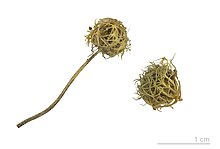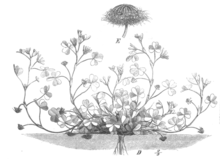Ground-fruity clover
| Ground-fruity clover | ||||||||||||
|---|---|---|---|---|---|---|---|---|---|---|---|---|

Ground fruity clover ( Trifolium subterraneum ) ( Herbarium evidence ) |
||||||||||||
| Systematics | ||||||||||||
|
||||||||||||
| Scientific name | ||||||||||||
| Trifolium subterraneum | ||||||||||||
| L. |
The fruited clover ( Trifolium subterraneum ) is a species of the legume family (Fabaceae). It belongs to the section Trichocephalum in the genus Klee ( Trifolium ). A special feature is the Geokarpie said propagation mechanism , the inflorescence after the fruit ripening in which in the ground drilled.
Description and ecology
Trifolium subterraneum is very diverse and is divided into several subspecies or varieties.
Vegetative characteristics
The fruit-bearing clover is an annual herbaceous plant . Its appearance is strongly reminiscent of Medicago - or even Oxalis species. The delicate-looking, slightly branched to unbranched stem grows prostrate or ascending, reaches lengths of usually 10 to 30 centimeters and is bald or protruding with shaggy hair. The alternate leaves are divided into a petiole and a leaf blade. The leaf blade is pinnate in three parts. The leaflets are 8 to 12 millimeters long and inverted heart-shaped.
Generative characteristics
The ground-fruity clover blooms mainly in March and April. The flower heads are usually about 1 centimeter long and contain ten to twelve about equally long, clearly curved flowers. The hermaphrodite flowers are zygomorphic and five-fold with a double flower envelope . The calyx teeth are almost as long as the calyx tube. The five petals are striped white and pink.
The ground fruity clover is particularly noticeable because it develops a so-called geocarpy : of the up to twelve flowers on a head, only three or four fruits develop. In the remainder, the shaggy calyxes grow into thick stems with five tentacle-shaped curved spines. Due to the strong curvature of the stretching inflorescence stalks, they penetrate up to 1.5 centimeters into the ground. The fruit heads located in the ground are then additionally anchored by the spines curving sideways and upwards again.
The lenticular seeds, about 2.5 millimeters long, are black in color.
The number of chromosomes is 2n = 16.
distribution
The distribution area of Trifolium subterraneum is the entire Mediterranean area and eastwards to the Middle East . He appears as a neophyte in England. In Central Europe, the ground-fruity clover is rarely found carried away and occurs only inconsistently, for example in Switzerland ( Zurich , Solothurn ) or Germany ( Baden-Württemberg , Northern Bavaria ).
literature
- Gustav Hegi, H. Gams, H. Marzell: Illustrated flora of Central Europe. Pteridophyta, Spermatophyta . 2nd Edition. Volume IV. Part 3: Angiospermae: Dicotyledones 2 (5) (Leguminosae - Tropaeolaceae) . Carl Hanser and Paul Parey, Munich and Berlin / Hamburg 1964, ISBN 3-489-70020-1 (unchanged reprint from 1923-1924 with addendum).
- Michael Zohary , David Heller : The Genus Trifolium . The Israel Academy of Sciences and Humanities, Jerusalem 1984, ISBN 965-208-056-X , pp. 525 f .
- John M. Gillett, Norman L. Taylor, M. Gillett: The World of Clovers . Iowa State University Press , Ames 2001, ISBN 978-0-8138-2986-9 , pp. 402 f .
Web links
- Trifolium subterraneum L., ground-blooming clover. In: FloraWeb.de.
- Distribution map for Germany. In: Floraweb .
- Trifolium subterraneum L. In: Info Flora , the national data and information center for Swiss flora . Retrieved November 18, 2015.
- Data sheet at International Legume Database Information Service = ILDIS - LegumeWeb - World Database of Legumes , Version 10.38 from July 20, 2010.


